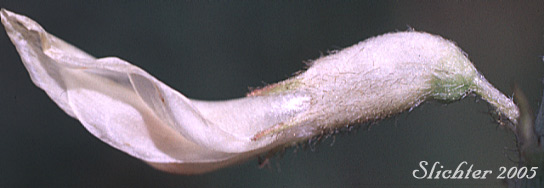
 The
photo at right shows yellow hedysarum as seen along the trail to Elk Ridge or
Elk Hill near the North Fork of the Sun River in the Bob Marshall Wilderness of
the Montana Rockies.........July 25, 1999.
The
photo at right shows yellow hedysarum as seen along the trail to Elk Ridge or
Elk Hill near the North Fork of the Sun River in the Bob Marshall Wilderness of
the Montana Rockies.........July 25, 1999.
Yellow hedysarum is an herbaceous perennial wildflower with several erect, branched stems arising from a thick crown atop a taproot. The stems rise from 30-60 cm high. The herbage of stems and leaves is consists of a sparse coat of greenish, short and stiff, appressed hairs. The pinnately compound leaves are alternately arranged along the stems and only slightly reduced in size upwards on the stem. They are divided into 9-21 dark green leaflets which are elliptic to oblong in shape and sharp-pointed at the tips. The ventral surface of the leaflets are conspicuously veined and each leaflet measures from 1-4 cm long.
The inflorescence consists of a raceme of 20-100 pale yellow to nearly white flowers held above the upper leaves. Individual flowers are pendant and measure from 14-18 mm long. The obtuse keel is longer than wings or banner. The calyx is tubular and measures 3-4 mm long with calyx lobes shorter than the tube. The upper two calyx lobes are shorter and wider than the longer, narrower trio of lower lobes. The pendant pods consist of 1-4 obovate-shaped segments, each 6-10 mm wide.
Yellow hedysarum may be found in open forests on moist to fairly dry soils from the lowlands to subalpine habitats in the mountains.
Yellow hedysarum may be found from the eastern slope of the Cascade Mts. from southern British Columbia south to Okanogan County in Washington and east to Alberta and south in the Rocky Mts to Montana and Wyoming.